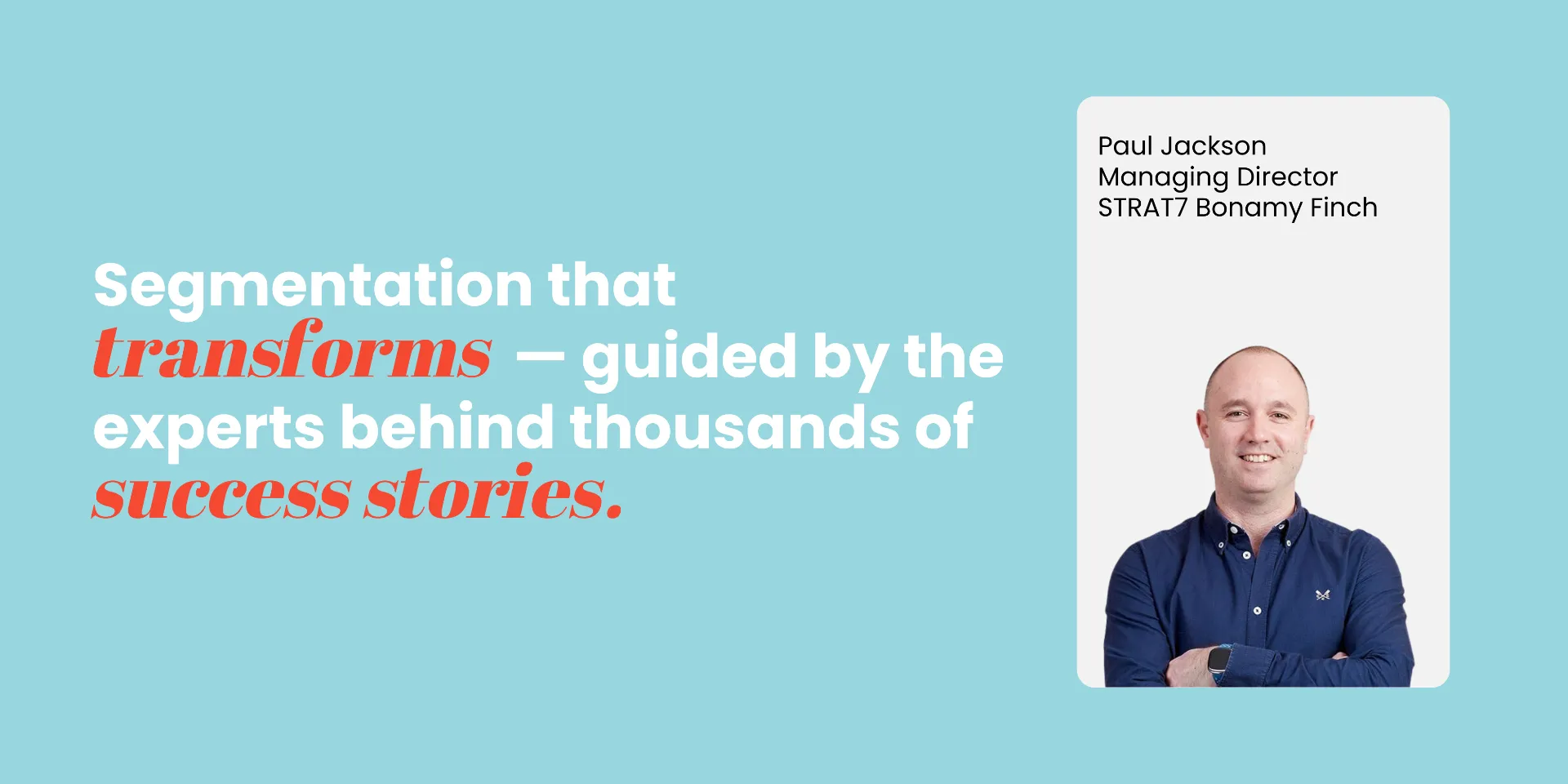You’ve decided to create customer segments. You know whether you want a survey-based, database, or hybrid approach. Now comes the crucial question: what data should you actually use to build your segmentation?
This decision will make or break your segmentation’s success. Choose the wrong data, and you’ll end up with segments that sound interesting but don’t drive business results. Choose the right data, and you’ll have segments that transform how your business grows.
The challenge is that there are many types of data you could use, each with different strengths and limitations. The key is understanding what each data type delivers, then combining them strategically based on your specific business context and goals.
The six types of segmentation data
1. Demographics
What it includes: Age, gender, income, location, education, family status, occupation
Benefits:
- Easy to collect and understand
- Simple to use for targeting across advertising platforms
- Readily available from most data sources
- Cost-effective to obtain
Limitations:
- Doesn’t reveal customer needs or motivations
- Limited value for product innovation
- Can reinforce stereotypes rather than reveal insights
- Often doesn’t predict actual purchasing behaviour
Best used when: You need basic targeting capabilities or want to understand the composition of other segments.
2. Behaviours
What it includes: Purchase history, website activity, app usage, channel preferences, frequency patterns
Benefits:
- Directly observable and measurable
- Excellent for retention strategies
- Easy to track and update automatically
- Strong predictor of short-term actions
Limitations:
- Doesn’t explain why customers behave as they do
- Limited ability to attract new customers
- Can be reactive rather than predictive
- May miss emotional or aspirational factors
Best used when: You want to optimise existing customer relationships or improve operational efficiency.
3. Personality & values
What it includes: Core values, personality traits, lifestyle preferences, general attitudes towards life
Benefits:
- Stable over time
- Great for high-level brand positioning
- Helps with emotional connection
- Useful for long-term strategic planning
Limitations:
- Difficult to use for specific product innovation
- Hard to translate into operational tactics
- May not predict category-specific behaviour
- Requires sophisticated research to uncover
Best used when: You’re developing brand strategy or entering new markets where emotional connection matters.
4. Attitudes
What it includes: Category-specific opinions, brand perceptions, risk tolerance, purchase priorities
Benefits:
- Directly relevant to your business decisions
- Great for market entry and expansion planning
- Helps identify positioning opportunities
- More actionable than general personality data
Limitations:
- Can change over time
- May not always predict actual behaviour
- Requires category-specific research
- Can be influenced by current market conditions
Best used when: You need to understand competitive dynamics or identify market opportunities.
5. Needs (the "why")
What it includes: Functional needs, emotional needs, job-to-be-done, pain points, desired outcomes
Benefits:
- Excellent foundation for product innovation
- Drives compelling marketing messages
- Helps identify unmet market opportunities
- Creates emotional connection with customers
Limitations:
- Can be harder to identify and target specific individuals
- May require creative interpretation for activation
- Needs can evolve as markets mature
- Requires deep customer research to uncover
Best used when: You’re developing new products or want to create differentiated positioning.
6. Situational factors (the "w's")
What it includes: When, where, with whom, for what occasion, under what circumstances
Benefits:
- Great for identifying specific opportunities
- Excellent for product development and innovation
- Helps with timing and channel strategies
- Reveals usage patterns and contexts
Limitations:
- Doesn’t reveal underlying motivations
- Can be complex to operationalise
- May require different approaches for different situations
- Hard to build consistent messaging around
Best used when: You have products used in multiple contexts or want to identify new usage occasions.
The data combination matrix
Each data type has serious limitations when used in isolation. The most effective segmentations combine multiple data types strategically:
| Data Type | Strength | Weakness when used alone |
|---|---|---|
| Demographics | Easy targeting | Doesn't understand needs |
| Behaviours | Useful for retention | Doesn't understand reasons |
| Personality & values | Brand positioning | Difficult for product innovation |
| Attitudes | Market positioning | Can't always predict behaviour |
| Needs | Product innovation | Harder to target |
| Situational | Opportunity spotting | Doesn't reveal motivations |
Two key frameworks for data selection
Framework 1: What matters most vs what you can use
What matters most: Use data-driven analysis to test which potential drivers best predict key business outcomes like category choice, customer value, and brand proximity.
Example: A telecommunications company tested 20 possible segmentation drivers against actual customer behaviours. They found strong links between household size, customer motivations, and product choices. This data-driven approach revealed that combining motivations with specific demographics would create the most predictive segments.
What you can use: Consider the practical constraints of your business – the data you currently collect, how your teams target customers, and what information your activation channels can utilise.
The sweet spot: The best segmentation data sits at the intersection of what statistically matters most and what you can practically use to drive business decisions.
Framework 2: Category context and purpose
Category context: Low purchase frequency
For categories where customers buy infrequently (cars, insurance, holidays), focus on:
- People-based data: Attitudes, motivations, and relationship with the category
- Involvement and engagement: How they research and make decisions
- Life context: Role the product plays in their broader lives
Example: Someone buying trainers isn’t just buying footwear – they’re buying into a lifestyle. A gym-goer has different needs than a sneaker collector, even if their demographics are identical.
Category context: High purchase frequency
For categories with frequent purchases (food, drinks, retail), focus on:
- Occasion-based data: When, where, with whom, for what purpose
- Situational needs: How needs change by context
- Moment-specific motivations: What drives choice in each situation
Example: The same person buying alcohol makes different choices for Saturday night with friends versus Sunday lunch with grandparents. The situation drives the decision more than their general personality.

Strategic data combination approaches
For person-based segmentation
Recommended combination: Demographics + Attitudes + Category Behaviours
This combination gives you:
- Targetable characteristics (demographics)
- Motivational understanding (attitudes)
- Actionable insights (behaviours)
For occasion-based segmentation
Recommended combination: Needs + Behaviours + Situational Factors
This combination provides:
- Why they choose (needs)
- What they actually do (behaviours)
- When and how context matters (situational)
For hybrid segmentation
Recommended combination: All data types, with emphasis on connecting survey insights to database behaviours
Practical data selection process
Step 1: Define your core questions
Before choosing data, clarify what business decisions your segmentation needs to inform:
- Which customers should we target?
- What products should we develop?
- How should we position our brand?
- Where should we focus our marketing spend?
Step 2: Test predictive power
If possible, test different data combinations against known business outcomes:
- Which data best predicts customer value?
- What factors most strongly influence brand choice?
- Which characteristics correlate with customer satisfaction?
Step 3: Assess practical constraints
Consider your operational realities:
- What data do you currently collect?
- How do your teams currently target customers?
- What can your activation channels actually use?
- What would require new capabilities to implement?
Step 4: Plan for evolution
Choose data that will remain relevant as your business grows:
- Will these factors matter in 2-3 years?
- Can you continue to collect this data cost-effectively?
- Does this data support multiple business functions?
Common data selection mistakes
Mistake 1: Over-relying on demographics
Demographics are easy but rarely sufficient. Age and income don’t tell you why someone chooses your brand or what they actually need.
Mistake 2: Behaviour-only segmentation
Transaction data shows what happened but not why. You’ll struggle to attract new customers or innovate products without understanding motivations.
Mistake 3: Too many data points
More data isn’t always better. Focus on the factors that most strongly predict the outcomes you care about.
Mistake 4: Ignoring practical constraints
Beautiful segments that you can’t actually target or activate are worthless. Always consider how you’ll use the data.
Real-world data selection example
A large telecommunications company needed to segment both existing customers and potential market opportunities. Here’s how they chose their data:
Step 1: They tested 20 potential data points against customer behaviours and value metrics.
Step 2: Analysis revealed that household size (demographic) and customer motivations (attitudinal) were the strongest predictors of product choice and usage patterns.
Step 3: They confirmed they could collect household size from their existing database and motivational data through targeted surveys.
Step 4: They validated that their marketing teams could target based on household size and create messages based on motivational insights.
Result: A hybrid segmentation that combined what statistically mattered most with what they could practically use, enabling both immediate customer targeting and longer-term strategic planning.
Getting started: Your data selection checklist
Before finalising your segmentation data, ask yourself:
- Business impact: Will this data help answer our core business questions?
- Statistical power: Does this data actually predict the outcomes we care about?
- Practical application: Can our teams use this data to make better decisions?
- Actionability: Can we target and activate based on this information?
- Sustainability: Can we continue collecting and using this data over time?
- Differentiation: Will this data reveal insights our competitors don’t have?
The path forward
Remember: the goal isn’t to collect every possible data point about your customers. It’s to identify the specific combination of data that will drive the business decisions you need to make.
Start with your business goals, test what actually predicts success, and choose the combination that balances statistical power with practical application. The best segmentation data is the data you’ll actually use to grow your business.
Next in our series: We’ll explore how different purchase frequencies and category contexts should shape your segmentation approach, with specific examples from trainers to alcohol to help you tailor your strategy.
